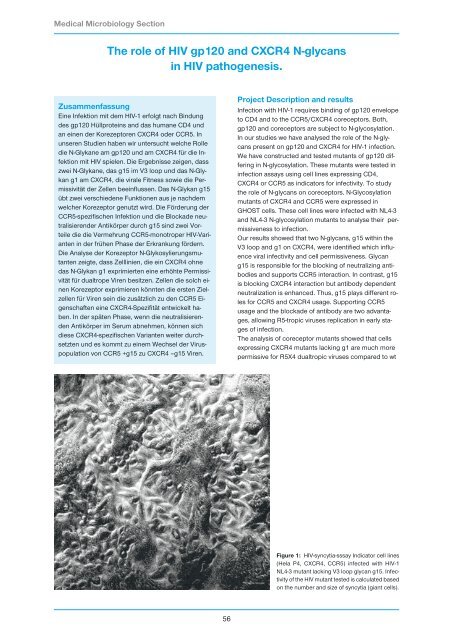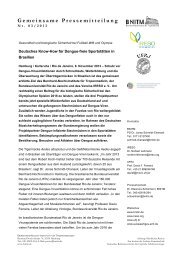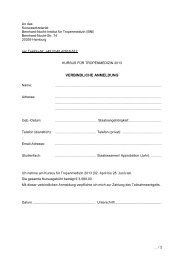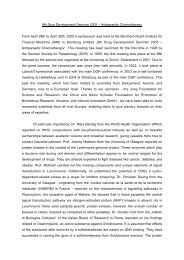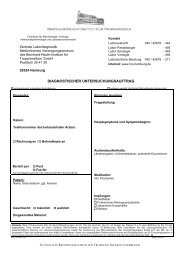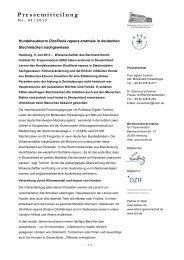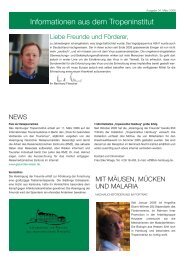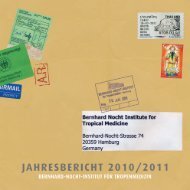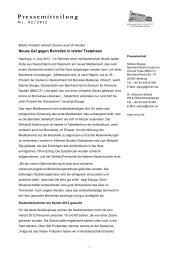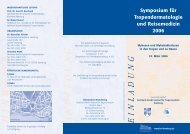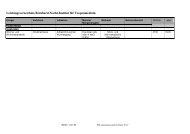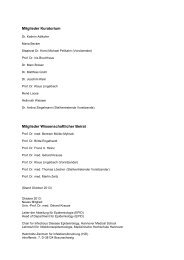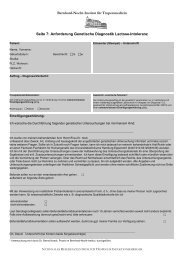Research Group Heussler (Malaria I) - Bernhard-Nocht-Institut für ...
Research Group Heussler (Malaria I) - Bernhard-Nocht-Institut für ...
Research Group Heussler (Malaria I) - Bernhard-Nocht-Institut für ...
Create successful ePaper yourself
Turn your PDF publications into a flip-book with our unique Google optimized e-Paper software.
Medical Microbiology Section<br />
The role of HIV gp120 and CXCR4 N-glycans<br />
in HIV pathogenesis.<br />
Zusammenfassung<br />
Eine Infektion mit dem HIV-1 erfolgt nach Bindung<br />
des gp120 Hüllproteins and das humane CD4 und<br />
an einen der Korezeptoren CXCR4 oder CCR5. In<br />
unseren Studien haben wir untersucht welche Rolle<br />
die N-Glykane am gp120 und am CXCR4 <strong>für</strong> die Infektion<br />
mit HIV spielen. Die Ergebnisse zeigen, dass<br />
zwei N-Glykane, das g15 im V3 loop und das N-Glykan<br />
g1 am CXCR4, die virale Fitness sowie die Permissivität<br />
der Zellen beeinflussen. Das N-Glykan g15<br />
übt zwei verschiedene Funktionen aus je nachdem<br />
welcher Korezeptor genutzt wird. Die Förderung der<br />
CCR5-spezifischen Infektion und die Blockade neutralisierender<br />
Antikörper durch g15 sind zwei Vorteile<br />
die die Vermehrung CCR5-monotroper HIV-Varianten<br />
in der frühen Phase der Erkrankung fördern.<br />
Die Analyse der Korezeptor N-Glykosylierungsmutanten<br />
zeigte, dass Zelllinien, die ein CXCR4 ohne<br />
das N-Glykan g1 exprimierten eine erhöhte Permissivität<br />
<strong>für</strong> dualtrope Viren besitzen. Zellen die solch einen<br />
Korezeptor exprimieren könnten die ersten Zielzellen<br />
<strong>für</strong> Viren sein die zusätzlich zu den CCR5 Eigenschaften<br />
eine CXCR4-Spezifität entwickelt haben.<br />
In der späten Phase, wenn die neutralisierenden<br />
Antikörper im Serum abnehmen, können sich<br />
diese CXCR4-spezifischen Varianten weiter durchsetzten<br />
und es kommt zu einem Wechsel der Viruspopulation<br />
von CCR5 +g15 zu CXCR4 –g15 Viren.<br />
56<br />
Project Description and results<br />
Infection with HIV-1 requires binding of gp120 envelope<br />
to CD4 and to the CCR5/CXCR4 coreceptors. Both,<br />
gp120 and coreceptors are subject to N-glycosylation.<br />
In our studies we have analysed the role of the N-glycans<br />
present on gp120 and CXCR4 for HIV-1 infection.<br />
We have constructed and tested mutants of gp120 differing<br />
in N-glycosylation. These mutants were tested in<br />
infection assays using cell lines expressing CD4,<br />
CXCR4 or CCR5 as indicators for infectivity. To study<br />
the role of N-glycans on coreceptors. N-Glycosylation<br />
mutants of CXCR4 and CCR5 were expressed in<br />
GHOST cells. These cell lines were infected with NL4-3<br />
and NL4-3 N-glycosylation mutants to analyse their permissiveness<br />
to infection.<br />
Our results showed that two N-glycans, g15 within the<br />
V3 loop and g1 on CXCR4, were identified which influence<br />
viral infectivity and cell permissiveness. Glycan<br />
g15 is responsible for the blocking of neutralizing antibodies<br />
and supports CCR5 interaction. In contrast, g15<br />
is blocking CXCR4 interaction but antibody dependent<br />
neutralization is enhanced. Thus, g15 plays different roles<br />
for CCR5 and CXCR4 usage. Supporting CCR5<br />
usage and the blockade of antibody are two advantages,<br />
allowing R5-tropic viruses replication in early stages<br />
of infection.<br />
The analysis of coreceptor mutants showed that cells<br />
expressing CXCR4 mutants lacking g1 are much more<br />
permissive for R5X4 dualtropic viruses compared to wt<br />
Figure 1: HIV-syncytia-sssay Indicator cell lines<br />
(Hela P4, CXCR4, CCR5) infected with HIV-1<br />
NL4-3 mutant lacking V3 loop glycan g15. Infectivity<br />
of the HIV mutant tested is calculated based<br />
on the number and size of syncytia (giant cells).


